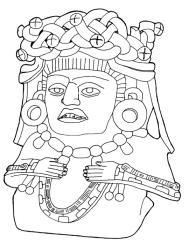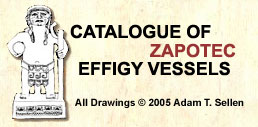| Key: MNA 6-4852 | | Actual Location: National Anthropology Museum, Mexico City, Mexico. | | Registration: 6-52 | | Provenance: Antechamber of tomb 103, no. 1, Monte Albán, Oaxaca. | | Measurements: 37 cm. | | Color: According to Caso's description, huipil: yellow with red tassel; face: red; hair | | Chronology: MA IIIB (Caso and Bernal 1952: 252); Peche 500 - 600 AD | | Click to view Chronology | | Reference: Caso 1938: 69, 70, 71, fig. 88; Caso & Bernal 1952: 288, fig. 437; Romero 1958: 210, plate XLV; Gendrop 1970: 138, fig. 159b. | | Comments: The piece was found in the antechamber of tomb 103, which was excavated by Caso during the sixth period (1937). Next to this piece, a pot with double pouring handle, decorated with a Cocijo head in front and with a black, polished cylindrical glass was found, as well as some fragments of earthenware bowls with fresco polychrome decorations. The tomb was dated MA IIIA-IIIB. See the other two effigy vessels of this tomb under MNA t/103 Nos. 2 and 3. | |
| | 
Click to view high resolution in a new window
select this image for review |
